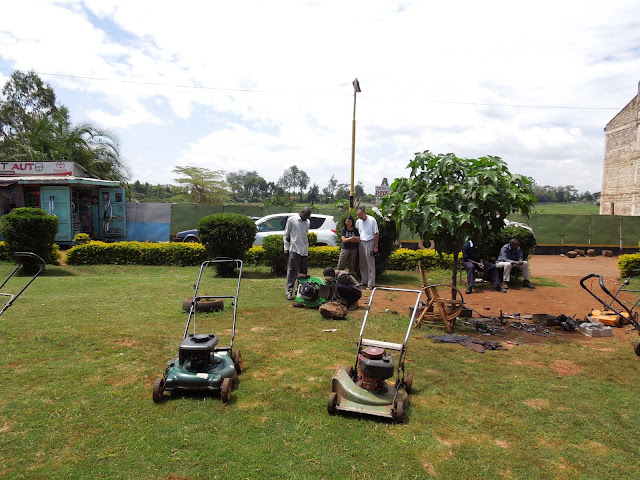 |
| 400 dollar used lawnmower |
According to Gongong, in Canada it costs 50 dollars to get a mechanic to agree to look at your broken lawn mower, then at least additional 100 to actually fix it. By comparison, a brand new lawnmower can be had for about 200 dollars. These economics invariably mean that nobody fixes lawnmowers in Canada. In a downward feedback spiral, the lack of demand further drives up repair service prices since the one remaining repairman has a monopoly and knows it. Not to mention you probably have to drive fifty miles out of town to find the guy.
Not in Kenya. Here it pays to repair lawnmowers. Our second hand mower cost us 400 dollars - and replacing it with a new one would be 500. But fixing it was less than 10 (700 Kenyan Shillings). Here is the story quoted from my father in law's diary:
Not in Kenya. Here it pays to repair lawnmowers. Our second hand mower cost us 400 dollars - and replacing it with a new one would be 500. But fixing it was less than 10 (700 Kenyan Shillings). Here is the story quoted from my father in law's diary:
The lawn mower was broken again. This time we took it to a repair shop with the gardener. We drove north through the new housing area called New Runda. Not long after we turn south on Kambu Road, there was a rest centre consisted of eating place in huts and a large gas station. There was also a large restaurant surround by a high wall. On the lawn in front of the gas station was the open repair shop with no hut or any structure. There were an old broken Indian made three wheeler tutut and five old lawn mowers on the lawn, and some tools scattered on the ground. The technician adjusted a valve to get the proper mixture of gas and air, and took off the blade for sharpening. It took him for about half an hour, and the mower was running properly again. He asked for KES 700 and Min paid him after consulting with the gardener. Min had told me that the fee for hiring a taxi driver was KES 700 for a day. This was probably the bench mark the technician used to decide his service fee.
 |
| Patrick, Min and Gongong at the Lawnmower Repair Store (check out the tools scattered all over the ground) |


















